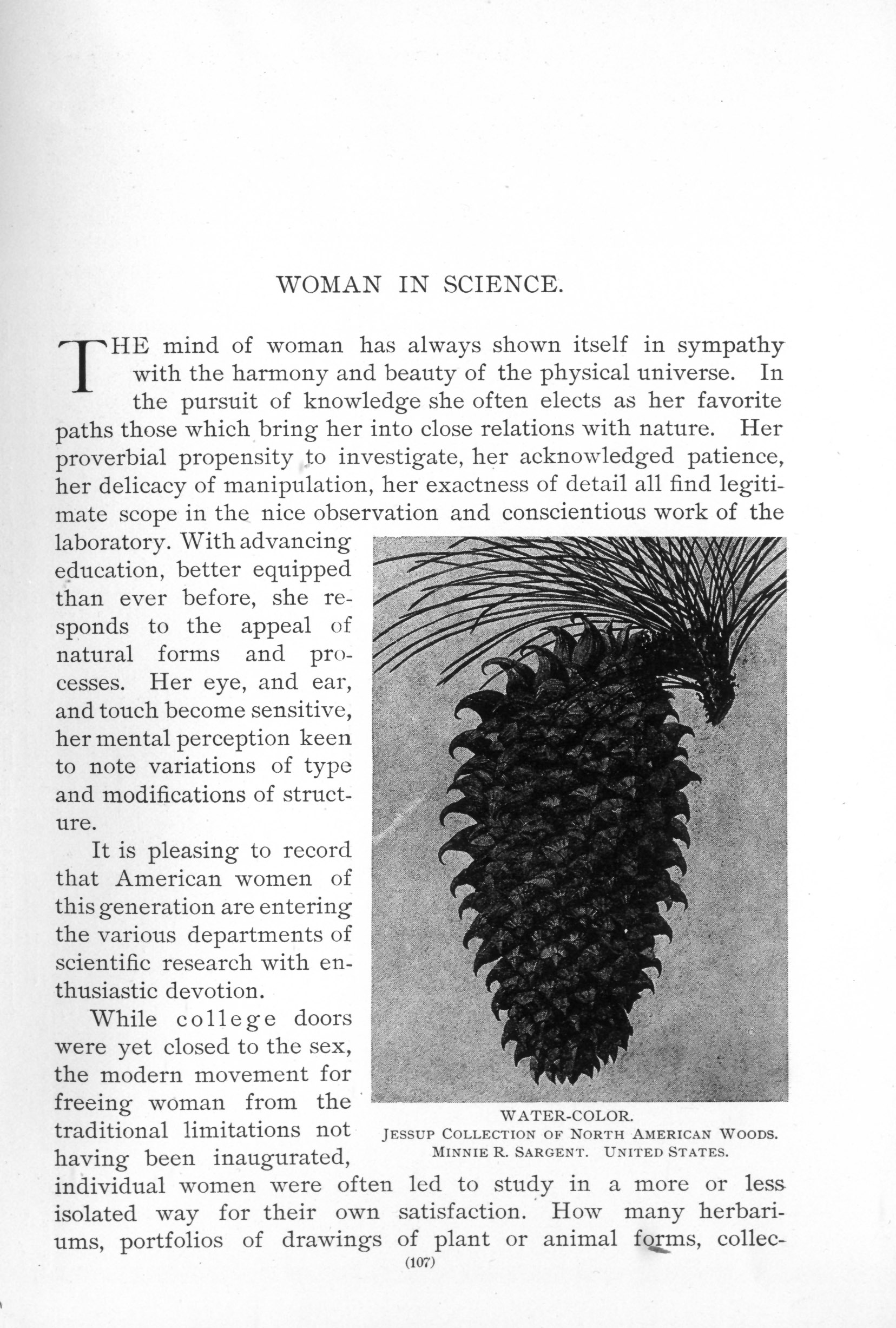
WATER COLOR.
JESSUP COLLECTION OF NORTH AMERICAN WOODS.
MINNIE R. SARGENT.
UNITED STATES.
WOMAN IN SCIENCE.
THE mind of woman has always shown itself in sympathy with the harmony and beauty of the physical universe. In the pursuit of knowledge she often elects as her favorite paths those which bring her into close relations with nature. Her proverbial propensity to investigate, her acknowledged patience, her delicacy of manipulation, her exactness of detail all find legitimate scope in the nice observation and conscientious work of the laboratory. With advancing education, better equipped than ever before, she responds to the appeal of natural forms and processes. Her eye, and ear, and touch become sensitive, her mental perception keen to note variations of type and modifications of structure.
It is pleasing to record that American women of this generation are entering the various departments of scientific research with enthusiastic devotion.
While college doors were yet closed to the sex, the modern movement for freeing woman from the traditional limitations not having been inaugurated, freeing woman from the traditional limitations not having been inaugurated, individual women were often led to study in a more or less isolated way for their own satisfaction. How many herbariums, portfolios of drawings of plant or animal forms, collec-
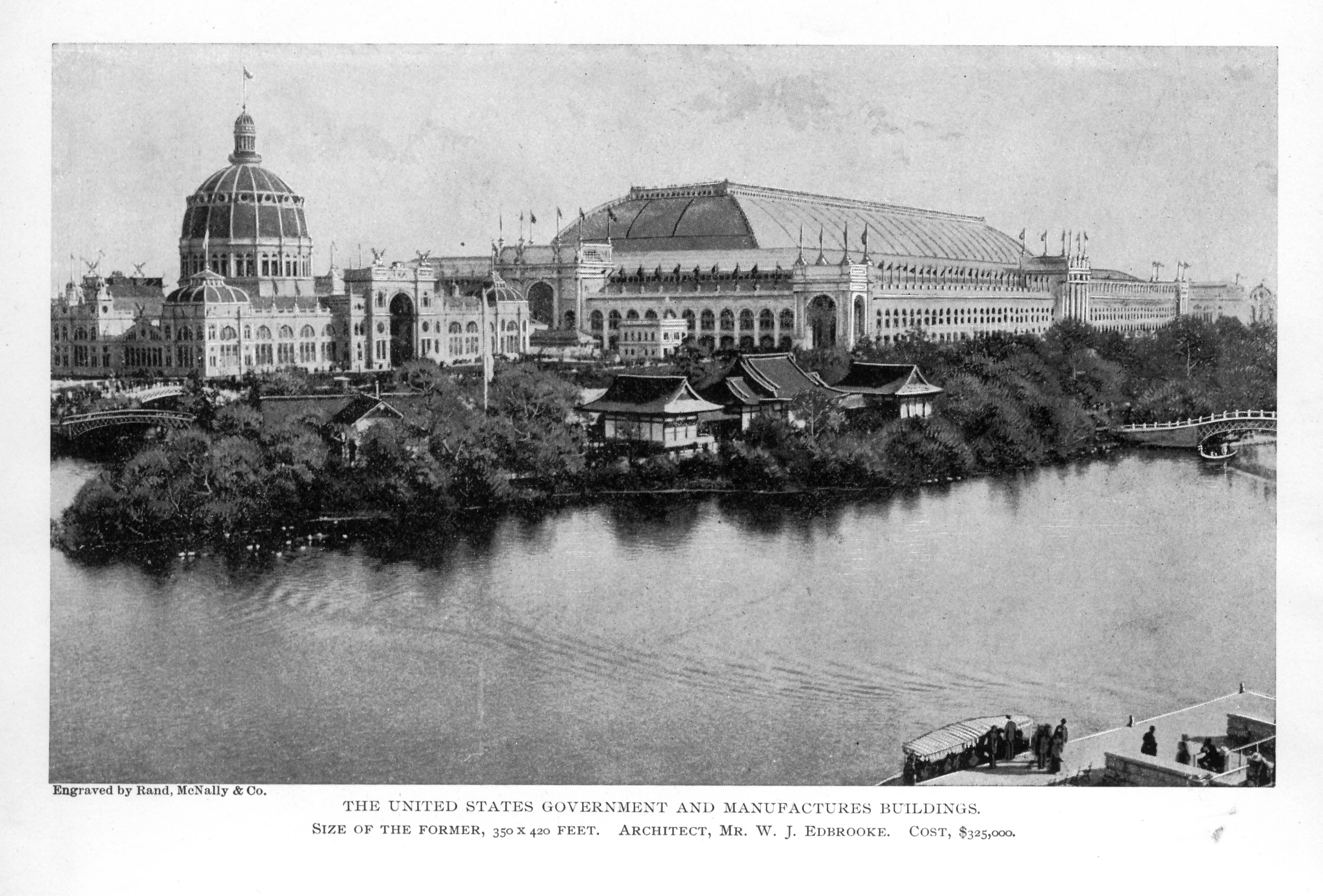
Engraved by Rand, McNally & Co.
THE UNITED STATES GOVERNMENT AND MANUFACTURES BUILDINGS.
SIZE OF THE FORMER, 350 X 420 FEET. ARCHITECT, MR. W. J. EDBROOKE. COST, $325,000.

OLD ENGLISH CLOCK IN CARVED WOOD CASE.
MRS. ELIOT.
ENGLAND.

Engraved by Rand, McNally & Co.
INTERIOR OF AGRICULTURAL BUILDING, AS SEEN FROM THE WESTERN GALLERY.
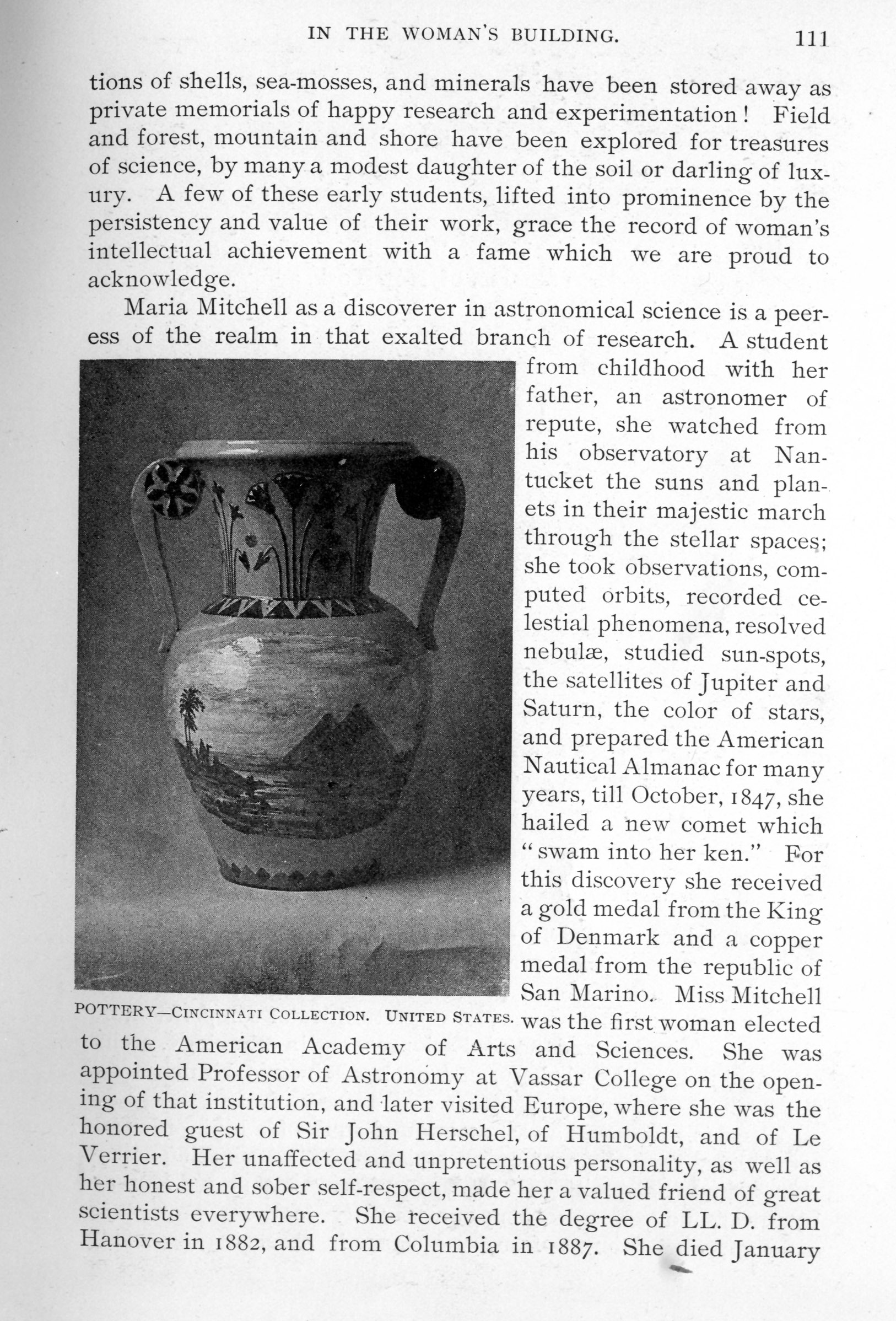
POTTERY—CINCINNATI COLLECTION.
UNITED STATES.
tions of shells, sea-mosses, and minerals have been stored away as private memorials of happy research and experimentation! Field and forest, mountain and shore have been explored for treasures of science, by many a modest daughter of the soil or darling of luxury. A few of these early students, lifted into prominence by the persistency and value of their work, grace the record of woman's intellectual achievement with a fame which we are proud to acknowledge.
Maria Mitchell as a discoverer in astronomical science is a peeress of the realm in that exalted branch of research. A student from childhood with her father, an astronomer of repute, she watched from his observatory at Nantucket the suns and planets in their majestic march through the stellar spaces; she took observations, computed orbits, recorded celestial phenomena, resolved nebulæ, studied sun-spots, the satellites of Jupiter and Saturn, the color of stars, and prepared the American Nautical Almanac for many years, till October, 1847, she hailed a new comet which "swam into her ken." For this discovery she received a gold medal from the King of Denmark and a copper medal from the republic of San Marino. Miss Mitchell was the first woman elected to the American Academy of Arts and Sciences. She was appointed Professor of Astronomy at Vassar College on the opening of that institution, and later visited Europe, where she was the honored guest of Sir John Herschel, of Humboldt, and of Le Verrier. Her unaffected and unpretentious personality, as well as her honest and sober self-respect, made her a valued friend of great scientists everywhere. She received the degree of LL. D. from Hanover in 1882, and from Columbia in 1887. She died January
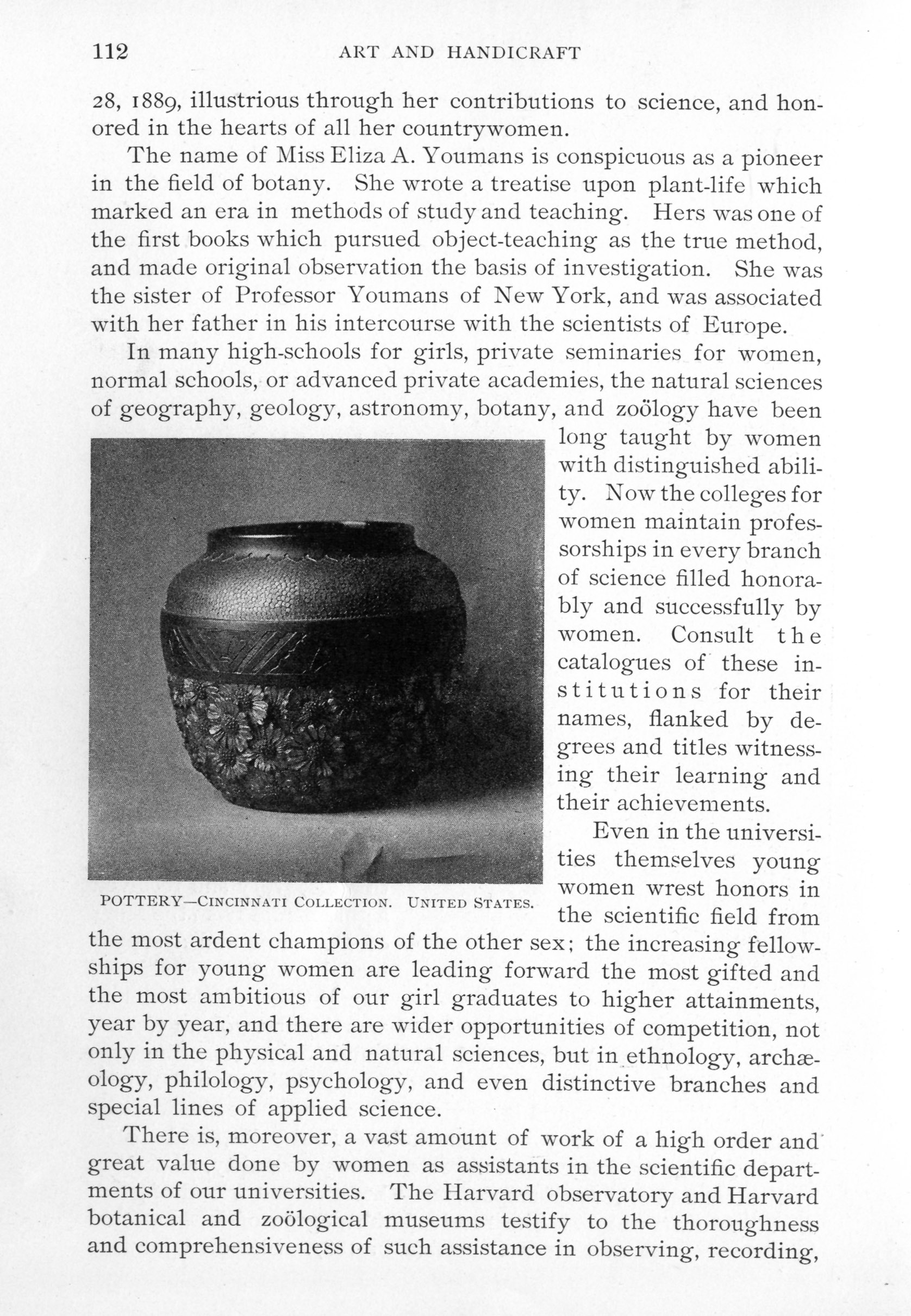
POTTERY—CINCINNATI COLLECTION.
UNITED STATES.
28, 1889, illustrious through her contributions to science, and honored in the hearts of all her countrywomen.
The name of Miss Eliza A. Youmans is conspicuous as a pioneer in the field of botany. She wrote a treatise upon plant-life which marked an era in methods of study and teaching. Hers was one of the first books which pursued object-teaching as the true method and made original observation the basis of investigation. She was the sister of Professor Youmans of New York, and was associated with her father in his intercourse with the scientists of Europe.
In many high-schools for girls, private seminaries for women, normal schools, or advanced private academies, the natural sciences of geography, geology, astronomy, botany, and zoölogy have been long taught by women with distinguished ability. Now the colleges for women maintain professorships in every branch of science filled honorably and successfully by women. Consult the catalogues of these institutions for their names, flanked by degrees and titles witnessing their learning and their achievements.
Even in the universities themselves young women wrest honors in the scientific field from the most ardent champions of the other sex; the increasing fellowships for young women are leading forward the most gifted and the most ambitious of our girl graduates to higher attainments, year by year, and there are wider opportunities of competition, not only in the physical and natural sciences, but in ethnology, archæology, philology, psychology, and even distinctive branches and special lines of applied science.
There is, moreover, a vast amount of work of a high order and great value done by women as assistants in the scientific departments of our universities. The Harvard observatory and Harvard botanical and zoölogical museums testify to the thoroughness and comprehensiveness of such assistance in observing, recording,
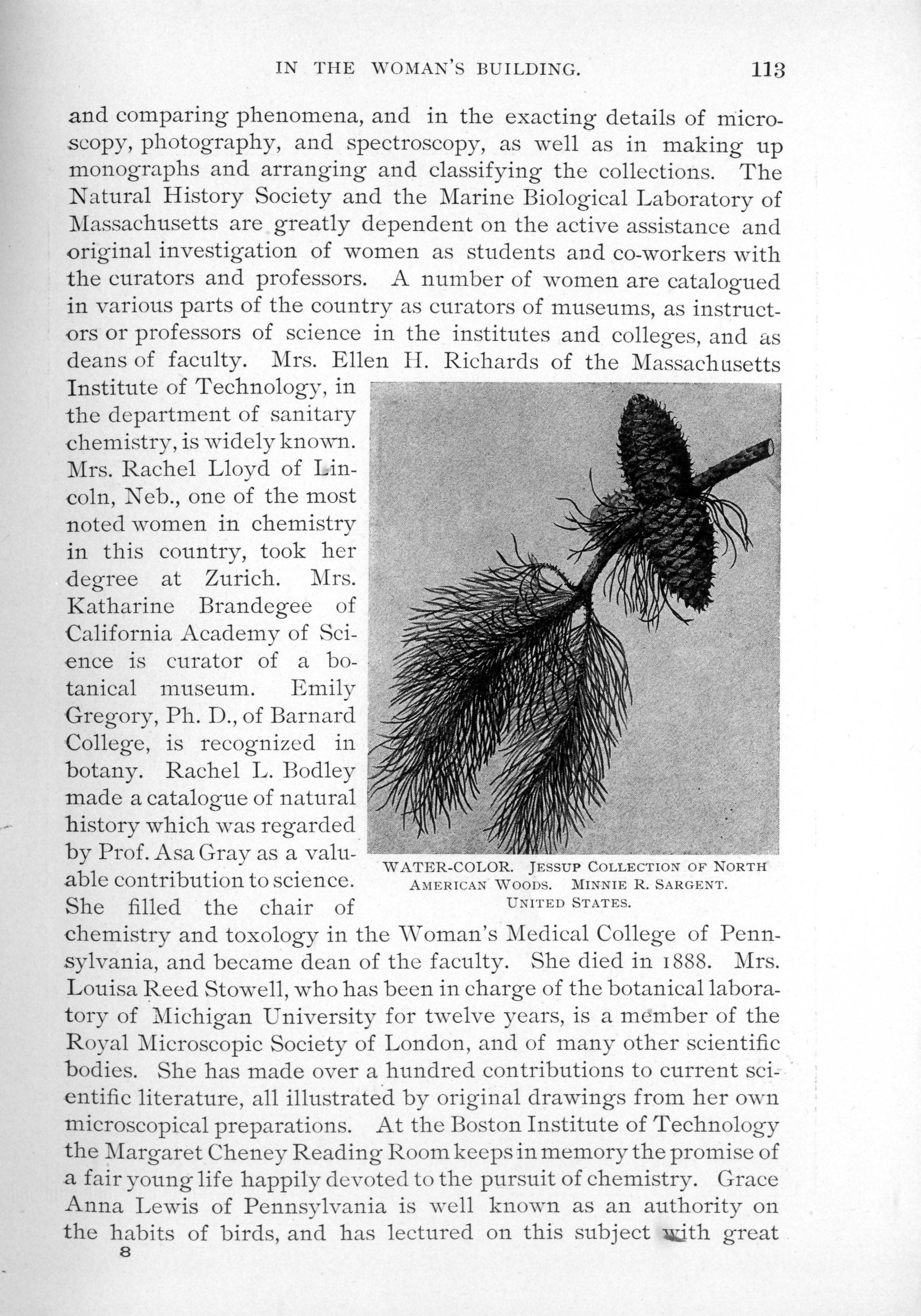
WATER COLOR.
JESSUP COLLECTION OF NORTH AMERICAN WOODS.
MINNIE R. SARGENT.
UNITED STATES.
and comparing phenomena, and in the exacting details of microscopy, photography, and spectroscopy, as well as in making up monographs and arranging and classifying the collections. The Natural History Society and the Marine Biological Laboratory of Massachusetts are greatly dependent on the active assistance and original investigation of women as students and co-workers with the curators and professors. A number of women are catalogued in various parts of the country as curators of museums, as instructors or professors of science in the institutes and colleges, and as deans of faculty. Mrs. Ellen H. Richards of the Massachusetts Institute of Technology, in the department of sanitary chemistry, is widely known. Mrs. Rachel Lloyd of Lincoln, Neb., one of the most noted women in chemistry in this country, took her degree at Zurich. Mrs. Katharine Brandegee of California Academy of Science is curator of a botanical museum. Emily Gregory, Ph. D., of Barnard College, is recognized in botany. Rachel L. Bodley made a catalogue of natural history which was regarded by Prof. Asa Gray as a valuable contribution to science. She filled the chair of chemistry and toxology in the Woman's Medical College of Pennsylvania, and became dean of the faculty. She died in 1888. Mrs. Louisa Reed Stowell, who has been in charge of the botanical laboratory of Michigan University for twelve years, is a member of the Royal Microscopic Society of London, and of many other scientific bodies. She has made over a hundred contributions to current scientific literature, all illustrated by original drawings from her own microscopical preparations. At the Boston Institute of Technology the Margaret Cheney Reading Room keeps in memory the promise of a fair young life happily devoted to the pursuit of chemistry. Grace Anna Lewis of Pennsylvania is well known as an authority on the habits of birds, and has lectured on this subject with great

BRONZE PLATE.
MARCELLE LANCELOT-CROCE.
FRANCE.

WATER-COLOR.
H. R. H. PRINCESS LOUISE,
OF DENMARK.
acceptance. Miss Cora Clarke of Jamaica Plain has made an exhaustive collection of galls, fungi, and mosses; Mrs. Lemmon, artist of the California Board of Forestry; Miss Marion Talbot of Chicago University, department of domestic science; and a host of others who fill responsible positions in all departments of science might swell the list far beyond the purpose or limits of this paper.
The department of biology seems to attract a large proportion of recent students, who meet the demands of laboratory work with great efficiency. The science of ethnology has been ably served by Miss Alice C. Fletcher of Massachusetts. She studied the archæological remains of the Ohio and Mississippi valleys, and went in 1881 to live among the Omaha Indians, under the auspices of the Peabody Museum of Archæology, for the further pursuit of archæology and ethnology. She has contributed results of great value, covering Indian traditions, customs, religious ceremonies, and many kindred subjects. She published a book on "Indian Civilization and Education" in 1886, and was then sent to Alaska to investigate the condition of the natives. She is now engaged in making allotments of land to the Omaha Indians, for which service she was appointed by the Government.
The scientific literature of women is becoming very extended. From the text-books of Mrs. Emma Willard and Mrs. Horace Mann, of Mrs. Louis Agassiz and Mrs. Richards, of Miss Crocker and Miss Arms, to the charming sketches of Olive Thorne Miller, we have a constantly increasing series of elementary works in natural science. The books of Miss Jane Newell of Cambridge, on botany; of Miss Julia McNair Wright, on plant and animal life, a series called "Seaside and Wayside," with other small but significant volumes intended to meet the popular interest and comprehension and arouse a love of scientific study, are pouring daily from the press.* The department of Elementary Science, or
* Mrs. Hopkins, the writer of this paper, is the author of "Educational Psychology," "A Hand-Book of the Earth," "Observation Lessons," "Elementary Science," etc.—ED.

ENAMELED GLASS.
ELLA CASELLA.
ENGLAND.

Natural Study, in the common schools is almost wholly in the hands of women as supervisors and teachers, and it can not be questioned that it is directed and presented with remarkable adaptation to the general need and the fostering of scientific methods of study, as well as a love of nature.
Directly in the line of pure science is Mrs. Mary Hemenway's undertaking in the department of archæology. Her southwestern archæological expedition, with its resulting museum, literature, and historical collections, is an invaluable foundation for future ethnological research, and is fruitful already of great results for the original study of American history. The collection accruing to the expedition and investigations thus far has been recently exhibited in Madrid, and proved prolific of results for so short a period. It is hoped that some permanent establishment of this museum of American archæology may be effected for the emulation of such noble scientific work as that of the late eminent Egyptologist, Miss Amelia B. Edwards.
It is impossible to convey an adequate idea of the promise of all these signs of the times in this brief résumé. It seems fitting that some flower of scientific expression, some emblem of the spirit of womanhood beautifying even the dry technicalities of the theme, should bring this paper to a close. We find this in a series of four hundred and twelve water-color paintings by Mrs. Charles S. Sargent of Brookline, prepared to illustrate the Jessup collection of North American woods in the American Museum of Natural History of New York, for a volume written and furnished by her husband. These illustrations are drawn from nature, the size of life, and for outline, color, grace, beauty, and scientific detail they are beyond criticism. Professor Goodale of Harvard University declares them to be unique and admirable in the realm of both science and art; the very spirit of the trees stirs in them, and a revelation of beauty and harmony greets us in these inimitable and loving studies from nature. Mrs. Sargent's drawings take the place in the delineation of native foliage that Audubon's matchless and exhaustive sketches hold in the representation of the birds of North America.
May we not assure ourselves that whatever woman's thought and study shall embrace will thereby receive a new inspiration; that she will save science from materialism, and art from a gross realism; that the "eternal womanly shall lead upward and onward?"
LOUISA PARSONS HOPKINS.

FAC-SIMILE OF BIBLE BELONGING TO QUEEN ELIZABETH.
ROYAL SOCIETY OF ART NEEDLEWORK. ENGLAND.